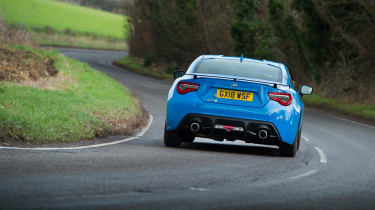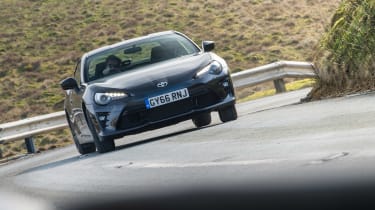Toyota GT86 (2012-2021) review – ride and handling
A mixed bag. The standard Michelin Primacy tyres don't do the chassis justice – but it's entertaining and interactive.
Whatever we might say about the GT86’s interior, it gets one thing very right: the driving position. Low-slung and with plenty of adjustability in the seats and wheel, just about everyone, no matter how big or small, should find a suitably comfortable and supportive driving position.
When you combine the innate rightness of the driving environment with fantastically direct steering, a great gearshift action and pedals ideally placed for heel-and-toe shifts, the GT86 becomes a car that shrinks around you, connecting you to the road via well-balanced control weights and a low hip-point.
You also get the feeling when sitting in the GT86 that the centre of gravity is practically scraping the tarmac – Toyota says it's lower than you'll find in a Porsche Boxster. The flat-four engine is low and compact, while the minimalist approach to the cabin (though the facelifted 2017 model has in fairness upped overall ‘plushness’ a little) meant Toyota was able to keep weight low, at 1222kg.
The ride can be harsh at low speeds (it's better on the Sachs units), but it stops well short of being truly punishing – several hot hatches are less forgiving. The car's low stance helps reduce any tendency to pitch and roll, and to this end the 2017-onwards models have thicker anti-roll bars than before, a stiffer bodyshell, and the transmission cross-member has also been reinforced.
The GT86 starts making sense when you start to push it. The grip limit of the rear tyres arrives much sooner than you might expect, but the traction control is especially keen to intervene, so beginners need not worry. However, for those who are no longer beginners, from 2017 there’s a ‘Track’ mode. This sets the traction and stability control system to minimum intervention, giving you plenty of freedom to play with the rear axle and enjoy the car’s sweet balance but with the ultimate reassurance of a safety net. Indeed, with (very) generous use of the throttle, the car will hold big angles before the electronics clamp down on the fun.
Many will still prefer to have all the safety systems completely off, though, such is the balance and predictability of the GT86 chassis. You’ll have to work it to get the car dancing, largely thanks to the lack of torque, but the trade-off is that you’ll likely do so within the speed limit. In the wet, you need to be a little more judicious as the GT86 can become unruly with marked shifts in momentum, especially with the VSC switched off.
The standard-fit low-rolling-resistance tyres, meanwhile, tend to deform quite markedly in hard cornering, which blunts steering response somewhat. While the low-grip tyres give the car an adjustability and sense of fun at medium and humble speeds, the consequence is that in faster corners confidence is in short supply.
The GT86 is perhaps the most democratised rear-wheel-drive performance car on sale, but as for the accessibility of its driving thrills, more experienced drivers will quickly want more grip and precision in the chassis, better body control and, of course, more power.





